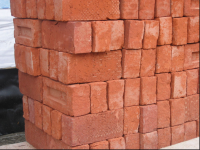








William Weston Young (1776–1847) Quaker Entrepreneur of Bristol and Glamorganshire; artist, botanist, wreck-raiser, surveyor, potter, and inventor of the firebrick.
Fired bricks are burned in a kiln which makes them durable. Modern, fired, clay bricks are formed in one of three processes – soft mud, dry press, or extruded.
Normally, brick contains the following ingredients:
*Silica (sand) – 50% to 60% by weight
*Alumina (clay) – 20% to 30% by weight
*Lime – 2 to 5% by weight
*Iron oxide – ? 7% by weight
*Magnesia – less than 1% by weight
The soft mud method is the most common, as it is the most economical. It starts with the raw clay, preferably in a mix with 25–30% sand to reduce shrinkage. The clay is first ground and mixed with water to the desired consistency. The clay is then pressed into steel moulds with a hydraulic press. The shaped clay is then fired (""burned"") at 900–1000 °C to achieve strength.
Rail kilns:
In modern brickworks, this is usually done in a continuously fired tunnel kiln, in which the bricks are fired as they move slowly through the kiln on conveyors, rails, or kiln cars, which achieves a more consistent brick product. The bricks often have lime, ash, and organic matter added, which accelerates the burning process.
Bull's Trench Kilns:
In India, brick making is typically a manual process. The most common type of brick kiln in use there is the Bull's Trench Kiln (BTK), based on a design developed by British engineer W. Bull in the late 19th century.
An oval or circular trench is dug, 6–9 metres wide, 2-2.5 metres deep, and 100–150 metres in circumference. A tall exhaust chimney is constructed in the centre. Half or more of the trench is filled with ""green"" (unfired) bricks which are stacked in an open lattice pattern to allow airflow. The lattice is capped with a roofing layer of finished brick.
In operation, new green bricks, along with roofing bricks, are stacked at one end of the brick pile; cooled finished bricks are removed from the other end for transport to their destinations. In the middle, the brick workers create a firing zone by dropping fuel (coal, wood, oil, debris, and so on) through access holes in the roof above the trench.
The advantage of the BTK design is a much greater energy efficiency compared with clamp or scove kilns. Sheet metal or boards are used to route the airflow through the brick lattice so that fresh air flows first through the recently burned bricks, heating the air, then through the active burning zone. The air continues through the green brick zone (pre-heating and drying the bricks), and finally out the chimney, where the rising gases create suction which pulls air through the system. The reuse of heated air yields savings in fuel cost.
As with the rail process above, the BTK process is continuous. A half dozen labourers working around the clock can fire approximately 15,000–25,000 bricks a day. Unlike the rail process, in the BTK process the bricks do not move. Instead, the locations at which the bricks are loaded, fired, and unloaded gradually rotate through the trench.
Dry pressed bricks:
The dry press method is similar to the soft mud brick method, but starts with a much thicker clay mix, so it forms more accurate, sharper-edged bricks. The greater force in pressing and the longer burn make this method more expensive.
Extruded bricks:
For extruded bricks the clay is mixed with 10–15% water (stiff extrusion) or 20–25% water (soft extrusion) in a pugmill. This mixture is forced through a die to create a long cable of material of the desired width and depth. This mass is then cut into bricks of the desired length by a wall of wires. Most structural bricks are made by this method as it produces hard, dense bricks, and suitable dies can produce perforations as well. The introduction of such holes reduces the volume of clay needed, and hence the cost. Hollow bricks are lighter and easier to handle, and have different thermal properties from solid bricks. The cut bricks are hardened by drying for 20 to 40 hours at 50 to 150 °C before being fired. The heat for drying is often waste heat from the kiln.
European-style extruded bricks or blocks are used in single-wall construction with finishes applied on the inside and outside. Their many voids comprise a greater proportion of the volume than the solid, thin walls of fired clay. Such bricks are made in 15-, 25-, 30-, 42- and 50-cm widths. Some models have very high thermal insulation properties, making them suitable for zero-energy buildings.